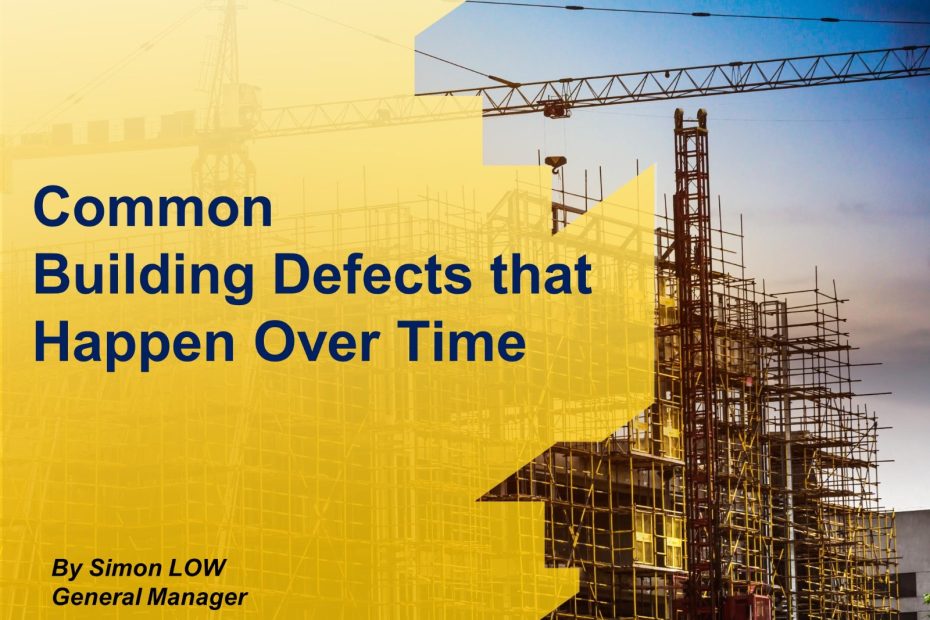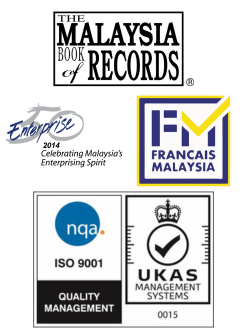Author: Simon LOW | 31 January, 2024
INTRODUCTION
Building defects are always a grave concern in the construction industry. Generally, building defect refers to the deficiency in the construction process that results in the failure of the ability of the building to deliver services as expected [1]. If left untreated, it may impact the building structure and aesthetic value. Most defects are typically discovered long after the completion of a project. Regardless of whether the defect is minor or major, managing the defect could be costly and time-consuming.
Building defects are common problems to house owners nowadays due to factors such as poor workmanship, low quality of construction material, climatic conditions, or design deficiency. House owners need to be equipped with some basic knowledge to identify the building defects so that the building defects can be rectified before it is too late.
BUILDING DEFECTS
- Tile popping
The process known as “tile popping” occurs when floor tiles begin to push against one another and eventually cause the floor tiles ‘pop’ up from their original place. This defect might appear in all types of tiles which include ceramic tile, marble tile, granite tile, etc. Some common factors that could lead to popped tiles are inadequate cleaning before tiling, lack of expansion joints, exerted load, poor quality or no adhesives, and sudden temperature changes. Also, when the tiles are too old, their flexibility decreases possibly due to long foot traffic or too much use of cleaning agent. The tiles eventually pop out, break or bend, thus causing unevenness in the floor. When tiles get dislodged and pop without warning, it can pose hazards to the occupants.
- Waterproofing issues
Waterproofing is the process of making a structure impervious or water-resistant. It can be done by applying a physical membrane to the external or internal surface of the structure to prevent water from penetrating into it. Some typical waterproofing materials are polyurethane, cementitious coating, EPDM rubber, and PVC waterproofing membrane [2]. Common causes of waterproofing failure include improper installation of waterproofing membrane, puncturing the waterproofing membrane after installation, weathering, and wrong product selection. Waterproofing failure may lead to water seepage which can accelerate the degradation of building due to moisture build-up. Hence, regular checks are important so that remedial waterproofing can be done timely before it turns into a major problem.
- Electrical defects
As the house ages, there will be electrical problems such as dimming lights, overlamping, frequently tripping breakers, and warm outlets. Since some houses were built before many modern gadgets and appliances were invented, our increased energy demand can overburden an old and outdated electrical system, resulting in fire or electrocution. Besides, there are electrical defects such as improper installation of electrical wiring and panels. For example, some wirings that are not sleeved properly, or the use of incompatible electrical units can result in an electrical trip which is a potential cause for hazardous fire incidents.
- Biological deterioration
Another disastrous building defect would be biological deterioration caused by living organisms. For instance, rats, cockroaches, termites, mosquitoes, and fungi. Fungi attack timber with high moisture level, causing discoloration and decaying of the timber. Most of the pests can spread viruses and cause diseases to the occupants inside the building. Among all the household pests, termites are the most destructive as they destroy almost everything including materials made of woods, fibres, and even synthetic materials which are not too hard or repellent. Building materials such as pillars, window and door frames, roof struts, and floor coverings that are made of wood are prone to termite attack. It can result in cosmetic damage and structural damage as termites eventually bore out the wood members.
- Cracking
The cracks in a building can be classified into structural cracks and non-structural cracks. The former poses a threat to the integrity and stability of the building structure while the latter does not. Non-structural cracks include those around the opening such as doors and windows. These kinds of cracks can be repaired easily by applying repair mortar and wire meshes. Structural cracks are usually found in beams, columns, and walls and these cracks could be caused by ground settlement, excessive movement of the building structure, serious overloading, or any other external forces applied to it. Structural cracks can accelerate the aging process and reduce the ability of a structure to absorb stress, increasing the risk of collapse. If cracks are detected, a monitoring plan should be drawn up immediately.
- Foundation settlement
Foundation settlement is when the soil supporting the foundation shift or sinks into the earth, compromising the building’s structural integrity. Typical causes of foundation settlement are soil consolidation, changes in soil moisture, poorly compacted soil, and vibration from seismic activities or nearby road traffic. Foundation settlement can be categorized into uniform and differential settlement. Uniform settlement occurs when a building foundation settles at the same rate throughout all portions, and it normally causes minor or no effect on the structure. Unlike uniform settlement, differential settlement occurs as a result of the non-uniform movement of underlying soil which can lead to uneven settling of foundation along with the structure above. In fact, differential settlement causes much more severe damage to a building than uniform settlement. The additional shear, bending stress, and torsion in the structural members due to differential settlement may lead to cracks and structural tilts.
- Roof leakage
Roof acts as a weather protection shield for the building structure and the greatest threat to the roof is leakage. Roof leakage is typically due to displaced or damaged roof tiles caused by high wind and heavy storms, improper installation of the underlayment, and poor waterproofing. Some common roof types are the flat roof, gable roof, and hip roof. The water entering from the roof can affect the integrity of the building structure. For instance, water seeping into the concrete slab flat roof will lead to corrosion of reinforcement. Leakage at the roof may cause the ceiling and the drywall to become stained which encourage mold growth. Regular inspections are the best defence against a leaky roof before it turns into a damaging and costly repair
- Plumbing issues
Plumbing issues may be due to aging fixtures, normal wear and tear on plumbing equipment, or poor maintenance of the system. Sluggish toilets, leaking pipes, faulty water heaters, sewer system backup, and clogged drainage are some common plumbing problems. The consequence of leakage in plumbing includes dampness in the surrounding walls. Dampness may promote the infestation of mold which can deteriorate the concrete structure, weakening its strength. When the drains are clogged and water starts pooling, they become breeding ground for insects and bacteria that carry diseases. There will be foul-smelling odours entering the house too.
- Wall finishes problems
Most of the finishes of buildings are paints and plasters. It is normal to see paint peeling off due to high exposure to sunlight and rainwater, or wavy surface of plasters due to poor workmanship. Another wall finishes problem is efflorescent (whitish bleeding) which can be spotted on the wall surface. This is due to the chemical reaction between the wall materials and the high moisture content on the wall during the painting process. Even though these wall finishes problems do not bring any structural concern to the buildings, it will affect the aesthetic value, making the buildings look old and lifeless.
- Corrosion of reinforced steel
Corrosion of reinforced steel is one of the major building defects that cause deterioration in reinforced concrete structures. Corrosion can lead to excessive cracking, delamination, and loss of cross-sectional area of reinforcing steel. In a more serious situation, it can cause ultimate spalling of concrete cover which can result in building collapse due to loss of bond between concrete and corroding reinforcement. All of these can affect the strength and ductility of reinforced concrete structures as well as their safety and serviceability performances. The occurrence of this building defect is high in buildings near the coast where the moisture and chlorine exposure is high. Therefore, a basic understanding of corrosion technology and maintenance is necessary to ensure the serviceability of the buildings.
- Tile popping
CONCLUSION
The common building defects mentioned above could be affecting our lives. There is no building that is immune to defects, regardless of its age. The defects in building elements are usually elusive to naked eyes, thus they are often overlooked. Failure to notice and address them with proper solutions will result in worsening the condition which can put occupants and the public at risk. Hence, maintenance of buildings is essential to ensure the buildings’ stability and serviceability performances.
Simon LOW
General Manager
IPM Professional Services Sdn Bhd
References:
[1] S Yacob., Azlan, & Cheong, AU. (2019). Establishing Relationship between Factors Affecting Building Defects and Building Conditions. Journal of Surveying, Construction and Property (JSCP), 10(1). https://ejournal.um.edu.mypublish/JSCP/
[2] Lorenzo W. (n.d.). 7 Common Types of Waterproofing Materials (Benefits, Uses, & Costs). Retrieved on 31st January 2024 from https://wtrproof.com/types-of-waterproofing-materials/
[3] Floor. Co. Popping tiles: What to DO with Your Ceramic Tiles Popping. Retrieved on 31st January 2024 from https://floornco.com/popping-tiles-singapore/
[4] Smart Concrete. (2021, October 22). What can External Waterproofing Membrane Failure Teach Architects about Sustainable Construction. Retrieved on 31st January 2024 from https://blog.kryton.com/2021/10/waterproofing-membrane-failure/
[5] Cyber-RT. (2019, June 2). Many fires due to multiple devices using same power socket. Retrieved on 31st January 2024 from https://www.cyber-rt.info/news/many-fires-due-to-multiple-devices-using-same-power-socket/
[6] Salam. (2022, August 30). 9 Warning Signs of a Termite Attack. Blogging Hub. Retrieved on 31st January 2024 from https://www.cleantechloops.com/termite-problem/
[7] Designing Buildings. (2022, October 28). Cracking and Building Movements. Retrieved on 31st January 2024 from https://www.designingbuildings.co.uk/wiki/Cracking_and_building_movement
[8] Wikipedia. Settlement (Structural). Retrieved on 31st January 2024 from https://en.wikipedia.org/wiki/Settlement_%28structural%29
[9] Webmaster. (2021, October 26). Some factors of roof leaks. SSPN-i. Retrieved on 31st January 2024 from https://tabungpendidikan.my/some-factors-of-roof-leak/
[10] depositsphoto. Retrieved on 31st January 2024 from https://depositphotos.com/stock-photos/leaking-pipe.html
[11] Lexie P, & Samantha. (2022, September 26). The best way to remove peeling paint from wall. Forbes Home. Retrieved on 31st January 2024 from https://www.forbes.com/home-improvement/paint/how-to-remove-peeling-paint/
[12] FPrimeC. (2016, August 3). Structural Effects of Corrosion. Retrieved on 31st January 2024 from https://www.fprimec.com/structural-effects-corrosion/

![Figure 1: Popped tiles [3]](https://ipm.my/wp-content/uploads/cache/2024/02/Tile-popping/3666781639.jpg)
![Figure 2: Waterproofing Failure [4]](https://ipm.my/wp-content/uploads/cache/2024/02/Waterproofing-issues/1103686945.jpg)
![Figure 3: Socket fire [5]](https://ipm.my/wp-content/uploads/cache/2024/02/Electrical-defects/2825465128.jpg)
![Figure 4: Termite Attack [6]](https://ipm.my/wp-content/uploads/cache/2024/02/Biological-deterioration/980255751.jpg)
![Figure 5: Cracks on wall [7]](https://ipm.my/wp-content/uploads/cache/2024/02/Cracking/3106200603.jpg)
![Figure 6: Foundation Settlement [8]](https://ipm.my/wp-content/uploads/cache/2024/02/Foundation-settlement/2663600504.jpg)
![Figure 7: Roof leakage [9]](https://ipm.my/wp-content/uploads/cache/2024/02/Roof-leakage/1903921431.jpg)
![Figure 8: Old leaky pipe [10]](https://ipm.my/wp-content/uploads/cache/2024/02/Plumbing-issues/1718840225.png)
![Figure 9: Peeling paint [11]](https://ipm.my/wp-content/uploads/cache/2024/02/Wall-finishes-problems/3345790750.jpg)
![Figure 10: Corrosion of reinforced concrete structure [12]](https://ipm.my/wp-content/uploads/cache/2024/02/Corrosion-of-reinforced-steel/2176822142.jpg)
